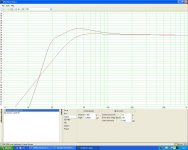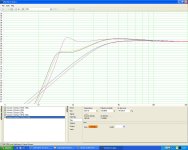No ! In a perfect world ,maybe , but not in this case .
Direct coupling of a driver to an amplifier should be the best .
First ,there's the (let's call it) coupling from mains to the amplifier (as any other audio electrical device ) by the means of the transformer . Then ,the current is rectified and smoothed by the rectifier and capacitor banks ,then amplified (through various stages ) ,most of the designs 99% use feedback to stabilize and obtaining good performance . Attaching a speaker to an amplifier output . What happens ? being a resistance ,that varies with frequency ,thus is an impedance ,it is a load for the amplifier and that causes voltage drop.The lower the impedance ,the more the voltage drops...or ...the amplifier tries to keep up with the energy request ,but strange things happen . At high power ,when driven hard ,transistors can't keep with current supply and voltage drop ,causing phase deviation from optimum zero . So they heat and may destroy when working out of SOA (safe operating area ).
So what are the causes ? Mainly also when the speaker system is not engineered with an eye to the amplifier side :Complicated crossover networks (just a coil or a cap cause a 90° phase rotation ...but that goes to the speaker ..or not ? I didn't say anything about Back EMF !!)and many speakers make the worst load that an amplifier may see ,having many dips and rise in the impedance chart ...
Obviously ...woofers' first cone break ups may be eliminated by any order of filter , as tweeters may benefit from a single cap high pass filter when not pushed hard .
Direct coupling of a driver to an amplifier should be the best .
First ,there's the (let's call it) coupling from mains to the amplifier (as any other audio electrical device ) by the means of the transformer . Then ,the current is rectified and smoothed by the rectifier and capacitor banks ,then amplified (through various stages ) ,most of the designs 99% use feedback to stabilize and obtaining good performance . Attaching a speaker to an amplifier output . What happens ? being a resistance ,that varies with frequency ,thus is an impedance ,it is a load for the amplifier and that causes voltage drop.The lower the impedance ,the more the voltage drops...or ...the amplifier tries to keep up with the energy request ,but strange things happen . At high power ,when driven hard ,transistors can't keep with current supply and voltage drop ,causing phase deviation from optimum zero . So they heat and may destroy when working out of SOA (safe operating area ).
So what are the causes ? Mainly also when the speaker system is not engineered with an eye to the amplifier side :Complicated crossover networks (just a coil or a cap cause a 90° phase rotation ...but that goes to the speaker ..or not ? I didn't say anything about Back EMF !!)and many speakers make the worst load that an amplifier may see ,having many dips and rise in the impedance chart ...
Obviously ...woofers' first cone break ups may be eliminated by any order of filter , as tweeters may benefit from a single cap high pass filter when not pushed hard .
PTC's are usually used to protect expensive compression drivers. They are usually connected in series with the CD or tweeter for HiFi. If you know how to use it (protection) is fine. Usually a (tube) lamp has a better effect as the PTC/fuses might not be fast enough....The symbol I used for the 100W Polyfuse is probably all wrong but that was the one that helps me to visualise the internal 'auto-protect-and-reset' action of the device. BTW they only cost 50c so if they save the drivers from overload as they should, then I think they are a good investment. My last 5 or 6 designs have included them on the crossover board.
Are you aware that the two zobels will at hi frequency bypass the inductors and form a resistive load on the amplifier.
Also for this to work well you need to measure the response of the drive units in the cabinet, then adjust the response to take into account cone break up and time differences.
Regards,
Andrew
Andrew
Also for this to work well you need to measure the response of the drive units in the cabinet, then adjust the response to take into account cone break up and time differences.
Regards,
Andrew
Andrew
Thats another $5 you earnt for your favourite site Pico! I really appreciate the genuine work you put into explaining the relationship of the output transistor and it's limited current capability. The 'phase' info is still in my memory bank and I will compute inbetween coffee's today. I find the back emf easy to visualise by looking at the coils as a 'spring' in the circuit; - a spring takes time to compress and then recoil.
You are another reader who believes a seperate amp is the go - to drive the bass speaker. I am a stubborn man, but my facade is crumbling!
I have a pair of brand new Athena (P3 I think) Subwoofer Amps with active filters and they deliver a huge amount of power via a pair of IRF630 mosfets in each unit. These chaps cost me $15 each including the transformer, so, the speakers can be built within my budget! They have an attractive control panel with a big bent flugelhorn-vent built in. The design of these amps have the bass speakers suspended 2 inches above the ground in a face down orientation towards the carpet or floor. The problem with that is that I can't see the big Red-Back spider that is embossed onto the woofers diaphragm! I can get around that by placing the bass bins on a mirrored tile like the ones on my bedroom ceiling!
You are another reader who believes a seperate amp is the go - to drive the bass speaker. I am a stubborn man, but my facade is crumbling!
I have a pair of brand new Athena (P3 I think) Subwoofer Amps with active filters and they deliver a huge amount of power via a pair of IRF630 mosfets in each unit. These chaps cost me $15 each including the transformer, so, the speakers can be built within my budget! They have an attractive control panel with a big bent flugelhorn-vent built in. The design of these amps have the bass speakers suspended 2 inches above the ground in a face down orientation towards the carpet or floor. The problem with that is that I can't see the big Red-Back spider that is embossed onto the woofers diaphragm! I can get around that by placing the bass bins on a mirrored tile like the ones on my bedroom ceiling!
Hi there Andy. This is the kind of input I was looking for. I will pop the last of my $5 donations in to the site today.
Yes, I did realise that the Zobels lower the impedance seen by the amplifiers output.
I have set up the speakers in various ways, for example series mids and parallell mids and the frequency v impedance curve shape is almost identical and what you would expect but for the fact that the series plot is centred at about 16R and the paralell is at 4R.
I would like to add one interesting observation here.
Recently I built a nice pair of 3-way tower speakers. they had a tweeter with its own hf filter, a midrange with a bandpass, and two odd 8 inch speakers in series as the bass drivers: The two bass speakers in each cabinet complimented each other in the series configuration, and what I eventually ended up with was a very flat freq. v impedance response and this was reflected in the data that I collected across the (paired) drivers intended frequency range. That is from 50Hz to 2kHz. One speaker was a 4 ohm dynalab salvage, and the other a DME 8 ohm 8 inch budget speaker. Together they sound great and my mates (OK my mate) reckon they sound allright for a set of home made jobs!
At the moment, my design is on paper, so I cant test the boxed response of each section of the speaker. However, I do have some idea of how to get a nice sound from each section by looking at other similar speakers and incorporating those ideas.
I am a Wood Machinist by trade, so I realise the work that goes into building a good sturdy box at home. Nothing is easy, from cutting a nice round hole for the speakers right through to sanding and spraying the finish. Usually by this stage I am well sick of that project and it stays just the way it was on paper! An icon to my insanity. It sits in the lounge room - with a story in it's MDF grain! Cant afford real wood! Just look at pictures of that stuff (available at the museum). I envy the blokes from up in the northern hemisphere with all their Cedar and Spruce. Couldn't you build a ripper out of some of those timbers. Do you have many softwoods in your location?
Yes, I did realise that the Zobels lower the impedance seen by the amplifiers output.
I have set up the speakers in various ways, for example series mids and parallell mids and the frequency v impedance curve shape is almost identical and what you would expect but for the fact that the series plot is centred at about 16R and the paralell is at 4R.
I would like to add one interesting observation here.
Recently I built a nice pair of 3-way tower speakers. they had a tweeter with its own hf filter, a midrange with a bandpass, and two odd 8 inch speakers in series as the bass drivers: The two bass speakers in each cabinet complimented each other in the series configuration, and what I eventually ended up with was a very flat freq. v impedance response and this was reflected in the data that I collected across the (paired) drivers intended frequency range. That is from 50Hz to 2kHz. One speaker was a 4 ohm dynalab salvage, and the other a DME 8 ohm 8 inch budget speaker. Together they sound great and my mates (OK my mate) reckon they sound allright for a set of home made jobs!
At the moment, my design is on paper, so I cant test the boxed response of each section of the speaker. However, I do have some idea of how to get a nice sound from each section by looking at other similar speakers and incorporating those ideas.
I am a Wood Machinist by trade, so I realise the work that goes into building a good sturdy box at home. Nothing is easy, from cutting a nice round hole for the speakers right through to sanding and spraying the finish. Usually by this stage I am well sick of that project and it stays just the way it was on paper! An icon to my insanity. It sits in the lounge room - with a story in it's MDF grain! Cant afford real wood! Just look at pictures of that stuff (available at the museum). I envy the blokes from up in the northern hemisphere with all their Cedar and Spruce. Couldn't you build a ripper out of some of those timbers. Do you have many softwoods in your location?
Hi,
since you seem to be quite serious about building these speakers I took a closer look at your drive units. I think you have a matching problem between them unless I have completely misinterpreted your crossover.
Your tweeter is listed as having a SPL of 93dB
Your Mid woof has an SPL of 90 db with two in parallel you will have an SPL of 96dB (or a bit less as they probably won't add perfectly)
You bass driver has an SPL of 85 dB.
This means with no pad on your tweeter and mid range your system will sound very bright through the 500Hz to 5KHz region and bright at the top.
The bass will be quiet as it is about 10dB lower than the mid range.
The first step towards solving this is to remove one of the mid woof drivers. If you limit the frequency range to 500Hz to 5KHz the mid woof will be able to cope with a 250W system power (Most of the power is in the bass below 300Hz and you have filtered this off)
So now you have 85dB vrs 90db vers 93dB
This is still going to sound very bright as the tweeter is still 8dB louder than the bass driver.
To resolve this you could use an L pad on the tweeter and midrange but you will be throwing quite alot of power away in the resistors and you will have an 85dB efficient system which is not great but it will probably give you good bass extension.
Have you already got these drive units? If not I would suggest looking for a set that match in terms of output level better. If you have then you will need quite alot of help with your crossover to make it work and sound good.
The impedance of your series crossover will be no higher than that of the equivalent parrallel circuit if you seperate it into two circuits as the regions of operation overlap in the same way. Plus you will have the advantage that the zobels will then be isolated from the amplifer by the xover inductors, outside the operating range of the drive unit they are attached to. This will reduce power dissipated in the zobel resistors and your amplifer.
If you really want to make this speaker I may be able to help you, but you will need measurements of the drive units in the cabinets; frequency response and impedance before I can come up with anything sensible and it will use alot of parts to get them to integrate well. If you can't take these measurments I may be able to come up with a guestimate starting point but you will then need to fiddle for a long time to get it to work well.
Your crossover will work in so much as the speaker won't explode but I think it will sound very bass light which is probably not what you want for an AV system.
If you use a seperate amplifer for the bass drivers this will solve some of the matching problem as you can turn the level up on the bass driver by approx 5dB.
You will still need a L pad on the tweeter to get it to match to your mid woof, but that is very common practice and should not be too hard to make work.
So I would alss recomend a seperate amp for the bass.
Regards,
Andrew
since you seem to be quite serious about building these speakers I took a closer look at your drive units. I think you have a matching problem between them unless I have completely misinterpreted your crossover.
Your tweeter is listed as having a SPL of 93dB
Your Mid woof has an SPL of 90 db with two in parallel you will have an SPL of 96dB (or a bit less as they probably won't add perfectly)
You bass driver has an SPL of 85 dB.
This means with no pad on your tweeter and mid range your system will sound very bright through the 500Hz to 5KHz region and bright at the top.
The bass will be quiet as it is about 10dB lower than the mid range.
The first step towards solving this is to remove one of the mid woof drivers. If you limit the frequency range to 500Hz to 5KHz the mid woof will be able to cope with a 250W system power (Most of the power is in the bass below 300Hz and you have filtered this off)
So now you have 85dB vrs 90db vers 93dB
This is still going to sound very bright as the tweeter is still 8dB louder than the bass driver.
To resolve this you could use an L pad on the tweeter and midrange but you will be throwing quite alot of power away in the resistors and you will have an 85dB efficient system which is not great but it will probably give you good bass extension.
Have you already got these drive units? If not I would suggest looking for a set that match in terms of output level better. If you have then you will need quite alot of help with your crossover to make it work and sound good.
The impedance of your series crossover will be no higher than that of the equivalent parrallel circuit if you seperate it into two circuits as the regions of operation overlap in the same way. Plus you will have the advantage that the zobels will then be isolated from the amplifer by the xover inductors, outside the operating range of the drive unit they are attached to. This will reduce power dissipated in the zobel resistors and your amplifer.
If you really want to make this speaker I may be able to help you, but you will need measurements of the drive units in the cabinets; frequency response and impedance before I can come up with anything sensible and it will use alot of parts to get them to integrate well. If you can't take these measurments I may be able to come up with a guestimate starting point but you will then need to fiddle for a long time to get it to work well.
Your crossover will work in so much as the speaker won't explode but I think it will sound very bass light which is probably not what you want for an AV system.
If you use a seperate amplifer for the bass drivers this will solve some of the matching problem as you can turn the level up on the bass driver by approx 5dB.
You will still need a L pad on the tweeter to get it to match to your mid woof, but that is very common practice and should not be too hard to make work.
So I would alss recomend a seperate amp for the bass.
Regards,
Andrew
Last edited:
Hello again Andy. I just wrote a reply to you and then it timed out - blast!
Oh well in a nutshell here is what I am thinking so far;
Everyone is worried about the SPL 'figure'. Fair enough.
The subbies SPL of 85 is a free air figure. I am guessing that its boxed SPL will be much higher. Am I wrong? Please, someone tell me.
The supplier of the speaker, Jaycar suggest a 140litre box with a vent of convenient diameter and volume of 844mL. 830x510x310 (HxWxD). What will a box of these dimensions do to my SPL figure of 85db? I would really like an answer to this question.
My hope is that there is someone out there with some practical subbie building experience that can give me an estimate of the difference between, SPL (free air) & SPL (vented enclosure) & SPL (sealed enclosure). Alternatively, there must be a university that has pledged to resolve such vital acoustic questions?
The tweeter is not yet selected and I could use some help to do that, once we all come to an agreement as to the real sensitivity of the boxed subbie.
I don't want to spend $100 per tweeter but $60 is OK.
The Mid-range section can loose one driver if the pair are too loud. I agree that one midrange driver should handle the power between 500Hz and 5kHz. The voice coil is not drawing as much power at the higher frequencies due to increase in its resistance, i.e. it's impedance.
I have plenty of spare amps if I need to use them, but the original design brief said that I am trying to build a budget full range speaker enclosure with an impedance of about 6 ohms.
I hope my stubborness doesn't put you all off. Please keep the ideas coming and I will keep on reading, there is no great big rush and there is much to be considered. I have gleaned a great deal of information from all of the generous responses and next time I build a box I will be thinking differently to the way I was when I posted that letter a week or so back!
Anyway, thanks again and bye for now, Phil Elliott
Oh well in a nutshell here is what I am thinking so far;
Everyone is worried about the SPL 'figure'. Fair enough.
The subbies SPL of 85 is a free air figure. I am guessing that its boxed SPL will be much higher. Am I wrong? Please, someone tell me.
The supplier of the speaker, Jaycar suggest a 140litre box with a vent of convenient diameter and volume of 844mL. 830x510x310 (HxWxD). What will a box of these dimensions do to my SPL figure of 85db? I would really like an answer to this question.
My hope is that there is someone out there with some practical subbie building experience that can give me an estimate of the difference between, SPL (free air) & SPL (vented enclosure) & SPL (sealed enclosure). Alternatively, there must be a university that has pledged to resolve such vital acoustic questions?
The tweeter is not yet selected and I could use some help to do that, once we all come to an agreement as to the real sensitivity of the boxed subbie.
I don't want to spend $100 per tweeter but $60 is OK.
The Mid-range section can loose one driver if the pair are too loud. I agree that one midrange driver should handle the power between 500Hz and 5kHz. The voice coil is not drawing as much power at the higher frequencies due to increase in its resistance, i.e. it's impedance.
I have plenty of spare amps if I need to use them, but the original design brief said that I am trying to build a budget full range speaker enclosure with an impedance of about 6 ohms.
I hope my stubborness doesn't put you all off. Please keep the ideas coming and I will keep on reading, there is no great big rush and there is much to be considered. I have gleaned a great deal of information from all of the generous responses and next time I build a box I will be thinking differently to the way I was when I posted that letter a week or so back!
Anyway, thanks again and bye for now, Phil Elliott
Hi, I also suffer with the time out sometimes, if you remember my way round this is to copy all the text to the copy buffer before pressing the send button.
This way if you have timed out all you need to do is open a new reply and paste the text in.
I don't always remember to do this so sometimes still loose replies.
I will take a look at your bass drivers specs and see if I can come up with a simulation. However you are not going to get more over all sensitivity whatever box you put it in. It will just change the low frequency roll off.
Regards,
Andrew
This way if you have timed out all you need to do is open a new reply and paste the text in.
I don't always remember to do this so sometimes still loose replies.
I will take a look at your bass drivers specs and see if I can come up with a simulation. However you are not going to get more over all sensitivity whatever box you put it in. It will just change the low frequency roll off.
Regards,
Andrew
I have worked out a simulation of your sub in a 140L box from the data available on Ebay AU. I used a free program calles Win ISD Pro alpha. The vented simulation uses a transmission line simulation as in experimental work I found it matches the real world response better.
This is the data I used:-
Re 3.2
Fs 30.9
Qms 7.698
Qts 0.71
Vas 69.49
As far as I can tell the value for Qes must be wrong as you can't have a Qts higher than either Qes or Qms so I let WINISA work this out and it thinks it should be 0.782 (So I let is use this). WINISA checks the integrity of T-S parametes and will not let you enter invalid combinations.
It is likely that Qms is correct as it is a parameter that can be directly measured. The Qts value seems about right for a car subwoofer this is why I assumed that Qes must be the value that is incorrect.
This lead to a revised SPL for this driver of 86dB rather than 85dB although this isn't really significant as this level of error is possible in the measurement.
The good news is I think there is a way to make this work as a system. When I looked at the values earlier I had forgotten that your sub is 4R and you mid is 8R. This will mean there is more power going to the sub that there is to the mid.
So for a 2.83V RMS input level the mid will have an output level of approx 90dB and be using 1W and the Sub will have an output level of 90dB but will be using 2.5W.
Since amplifiers work on a voltage output this means that for the same signal level going into the amplifer you will get the same signal level out of the mid and sub speakers (approx). They will just use different amounts of power.
I have done two simualtions both in 140L boxes one a closed box and the other a vented box tuned to 20Hz. Red is closed Black vented.
The closed box will give a nice easy to listen to controlled bass response and should not be too difficult to place in the room.
The vented box will give a deeper and much more powerfull response but may sound a bit out of control on occasion and may be a bit difficult to place as if it excites a bass room mode it will boom.
If you want this primarily for Home theater then the vented box would be a good choice and if its for music I would go with the closed box. If you go with the vent you can always stuff a sock in it if it gets out of control and it will tend to behave more like the closed box.
Regards,
Andy
This is the data I used:-
Re 3.2
Fs 30.9
Qms 7.698
Qts 0.71
Vas 69.49
As far as I can tell the value for Qes must be wrong as you can't have a Qts higher than either Qes or Qms so I let WINISA work this out and it thinks it should be 0.782 (So I let is use this). WINISA checks the integrity of T-S parametes and will not let you enter invalid combinations.
It is likely that Qms is correct as it is a parameter that can be directly measured. The Qts value seems about right for a car subwoofer this is why I assumed that Qes must be the value that is incorrect.
This lead to a revised SPL for this driver of 86dB rather than 85dB although this isn't really significant as this level of error is possible in the measurement.
The good news is I think there is a way to make this work as a system. When I looked at the values earlier I had forgotten that your sub is 4R and you mid is 8R. This will mean there is more power going to the sub that there is to the mid.
So for a 2.83V RMS input level the mid will have an output level of approx 90dB and be using 1W and the Sub will have an output level of 90dB but will be using 2.5W.
Since amplifiers work on a voltage output this means that for the same signal level going into the amplifer you will get the same signal level out of the mid and sub speakers (approx). They will just use different amounts of power.
I have done two simualtions both in 140L boxes one a closed box and the other a vented box tuned to 20Hz. Red is closed Black vented.
The closed box will give a nice easy to listen to controlled bass response and should not be too difficult to place in the room.
The vented box will give a deeper and much more powerfull response but may sound a bit out of control on occasion and may be a bit difficult to place as if it excites a bass room mode it will boom.
If you want this primarily for Home theater then the vented box would be a good choice and if its for music I would go with the closed box. If you go with the vent you can always stuff a sock in it if it gets out of control and it will tend to behave more like the closed box.
Regards,
Andy
Attachments
Hello again Andy, after a few beers and some deep reflection I have decided to cut my losses and simply make a couple of powered subbies from the 12" Venom speakers. They should be fit for that purpose. I just cant find one review that says a good word about them. Jaycar must have known it was never going to be popular, as they only stocked it for 2 or 3 years. It is not just the loudness issue, but a couple of punters report an artificial and unrealistic sound reproduction - those punters put it all down to the suspension and its 'off-road' & 4WD type characteristics. These people say her springs are a bit stiff and there's too much stiff in the shocks. I still intend to build a set of thumping great speakers, but will wait until I can identify the drivers that I want. Thanks again for all your help. Cheers and bye for now, Phil Elliott
as far as i can judge with my limited knowledge, you could do the following:
use the tweeters and midbass units to make a 2.5 way pair of speakers, purchase an inexpensive sub amp, and drive the car subs with that.
problem i can see with even this setup is, that most sub amps i'v seen are monoblocks.
And would not tolerate the 2 subs in paralell.
Connecting them in series would require high output voltage, and that would require an expensive(er) sub amp.
maybe if quality is less important then creativity i would risk getting a stereo car amp, and powering it with a DIY psu. Would be quite ugly solution, and probably would cost more than selling your bass units and 1 pair of the mid's, and getting a pair of proper bass drivers. Then you could go for 3 way setup. On the otherhand, a 3 way setup is far more complicated then a simple 2 way setup.
use the tweeters and midbass units to make a 2.5 way pair of speakers, purchase an inexpensive sub amp, and drive the car subs with that.
problem i can see with even this setup is, that most sub amps i'v seen are monoblocks.
And would not tolerate the 2 subs in paralell.
Connecting them in series would require high output voltage, and that would require an expensive(er) sub amp.
maybe if quality is less important then creativity i would risk getting a stereo car amp, and powering it with a DIY psu. Would be quite ugly solution, and probably would cost more than selling your bass units and 1 pair of the mid's, and getting a pair of proper bass drivers. Then you could go for 3 way setup. On the otherhand, a 3 way setup is far more complicated then a simple 2 way setup.
Crikeys Andy, a sock! Mine would rot the box out! Just one more simple question.I have worked out a simulation of your sub in a 140L box from the data available on Ebay AU. I used a free program calles Win ISD Pro alpha. The vented simulation uses a transmission line simulation as in experimental work I found it matches the real world response better.
This is the data I used:-
Re 3.2
Fs 30.9
Qms 7.698
Qts 0.71
Vas 69.49
As far as I can tell the value for Qes must be wrong as you can't have a Qts higher than either Qes or Qms so I let WINISA work this out and it thinks it should be 0.782 (So I let is use this). WINISA checks the integrity of T-S parametes and will not let you enter invalid combinations.
It is likely that Qms is correct as it is a parameter that can be directly measured. The Qts value seems about right for a car subwoofer this is why I assumed that Qes must be the value that is incorrect.
This lead to a revised SPL for this driver of 86dB rather than 85dB although this isn't really significant as this level of error is possible in the measurement.
The good news is I think there is a way to make this work as a system. When I looked at the values earlier I had forgotten that your sub is 4R and you mid is 8R. This will mean there is more power going to the sub that there is to the mid.
So for a 2.83V RMS input level the mid will have an output level of approx 90dB and be using 1W and the Sub will have an output level of 90dB but will be using 2.5W.
Since amplifiers work on a voltage output this means that for the same signal level going into the amplifer you will get the same signal level out of the mid and sub speakers (approx). They will just use different amounts of power.
I have done two simualtions both in 140L boxes one a closed box and the other a vented box tuned to 20Hz. Red is closed Black vented.
The closed box will give a nice easy to listen to controlled bass response and should not be too difficult to place in the room.
The vented box will give a deeper and much more powerfull response but may sound a bit out of control on occasion and may be a bit difficult to place as if it excites a bass room mode it will boom.
If you want this primarily for Home theater then the vented box would be a good choice and if its for music I would go with the closed box. If you go with the vent you can always stuff a sock in it if it gets out of control and it will tend to behave more like the closed box.
Regards,
Andy
Given that;
I can use the venom's for another project.
I don't have the tweeter yet.
No one has said anything good about the subbies in other forums.
I can use one midrange speaker instead of two.
Do you think I should cut my losses, and start with some more 'popular & well known drivers'?
I love the bass that comes out of my brothers big JBL home speakers and it blends beautifully with the treble from his tweeter. These speakers stand about 3' tall 18" wide and 12" deep. They have a 12" bass driver and a titanium tweeter.
I also have a nice old set of sound dynamics 100S that work beautifully too, they have a ported design like the JBL's and the phenolic tweeter again blends nicely. I am afraid these SD speakers are the best I have at the moment and although the specs say port resonance 34Hz I am left yearning for more. I cant hear a thing over 12k so bass is my only soother. I just can't stop thinking about those JBL's that have a beautiful soft rolling bass response (His Harmon Kardon Amp may have something to do with it too).
My brothers speakers made me think that I could do something similar at a fraction of the cost, but my thinking may be flawed.
The minimum standard that I would like to meet is of a quality similar to the above speakers. If I cant get a good sound out of these 'crappy car' subbies then I may just be putting a lot of effort into building another speaker that I really don't like.
Last edited:
Unfortunately I don't know the sound of the speakers you are talking about. I can't guarantee how they will sound but if you make a subwoofer from these drivers the sound quality is largely defined by the theoretical response up to about 100Hz. So if you don't try to use the above this range you should be able to make a good bass sound with them. So my approach would be to use the 12 inch drivers only for the deep bass. Extend the range over which you use the mid / woofers to integrate with the sub so they operate down to about 100Hz and choose a tweeter to go with them. I would go with a soft dome Vifa tweeter they are very good performance for the price. It doesn't matter if you end up having to pad the tweeter down a bit not much power will be lost this way as not that much of the power is in the HF part of the signal.
If you are interested I will rework the simulation and see what can be done with your sub. I suspect a much bigger box would work better but it depends on if you have space for it.
If you haven't designed a speaker before just use this as a learning experience then you can go for a more expensive design when you have a better feeling for what you want. You will end up with something that sounds OK and learn a massive amount about what speakers are all about.
Regards,
Andrew
If you are interested I will rework the simulation and see what can be done with your sub. I suspect a much bigger box would work better but it depends on if you have space for it.
If you haven't designed a speaker before just use this as a learning experience then you can go for a more expensive design when you have a better feeling for what you want. You will end up with something that sounds OK and learn a massive amount about what speakers are all about.
Regards,
Andrew
Reply to Andy
Spot on Andy. I'm with you on this. Logic, once again, has prevailed!
Speaker #1; I will use one 6.5" DME and the little $10 vifa silk dome tweeters in one box. I will commence this project in the next few months and post my re-hashed design for crossover, which will probably be just one cap and coil for the tweeter. I have downloaded winisd but it's asking me for a lot of data that I can't source. I just filled in the data that I did have on the woofer and it came up with a 20litre vented box tuned to 56Hz - sounds pretty good on paper! But as you say, if it is paired with a subbie then I may have some room to move with the design. I may only need to use a very small box or may be able to get a better response from my driver/tweeter combo if this woofer is tuned to; say 100Hz which is smack in the middle of my subbie-amp's bandwidth (50-150Hz).
The two Subbies (Speakers # 2); These are my priority at the moment. I have had a listen to the Athena P3 subbie amp and it sounds pretty healthy on one of the subs - even without the box! The amplifier has a vent pipe that is about 70mm inside diameter by 290mm long. With a bit of cut & shut I can adjust the length. See pictures below.
The only specs I can give you on the 12" Venom speaker are printed on the box. I don't yet understand to what these T&S parameters refer, but you sound like you're on top of it, Here they are again;
RE:3.2
QTS:0.71
BL: 11.1
Fs: 31
MMS: 177g
VAS: 57.7lt
SPL: 85db
RMS: 250W
I can't get an spl or f/Z chart although I can soon knock up an impedance chart if required, using my signal generator and a 10 Ohm resistor. But I guess we don't care about that any more as the amp is designed for 4 ohm speakers and there is only one of them in the box.
I am going to ask you to do me another favour! Can you please do your thing on the speaker design applet, just once more. I will follow whatever you tell me to do, but wont blame you if it goes horribly wrong as sometimes happens! (sh*t happens principle). I think that I will probably opt for a larger box, as MDF is cheap and bass needs deep?
I am now feeling much better about these subbies, as they are going to do what they were designed to do, but in a domestic application rather than automotive. I was drawn to the speakers by their very sturdy construction and big surrounds. I think they will go well, once you tweek up a big box for me!!! More pictures below;
Spot on Andy. I'm with you on this. Logic, once again, has prevailed!
Speaker #1; I will use one 6.5" DME and the little $10 vifa silk dome tweeters in one box. I will commence this project in the next few months and post my re-hashed design for crossover, which will probably be just one cap and coil for the tweeter. I have downloaded winisd but it's asking me for a lot of data that I can't source. I just filled in the data that I did have on the woofer and it came up with a 20litre vented box tuned to 56Hz - sounds pretty good on paper! But as you say, if it is paired with a subbie then I may have some room to move with the design. I may only need to use a very small box or may be able to get a better response from my driver/tweeter combo if this woofer is tuned to; say 100Hz which is smack in the middle of my subbie-amp's bandwidth (50-150Hz).
The two Subbies (Speakers # 2); These are my priority at the moment. I have had a listen to the Athena P3 subbie amp and it sounds pretty healthy on one of the subs - even without the box! The amplifier has a vent pipe that is about 70mm inside diameter by 290mm long. With a bit of cut & shut I can adjust the length. See pictures below.
The only specs I can give you on the 12" Venom speaker are printed on the box. I don't yet understand to what these T&S parameters refer, but you sound like you're on top of it, Here they are again;
RE:3.2
QTS:0.71
BL: 11.1
Fs: 31
MMS: 177g
VAS: 57.7lt
SPL: 85db
RMS: 250W
I can't get an spl or f/Z chart although I can soon knock up an impedance chart if required, using my signal generator and a 10 Ohm resistor. But I guess we don't care about that any more as the amp is designed for 4 ohm speakers and there is only one of them in the box.
I am going to ask you to do me another favour! Can you please do your thing on the speaker design applet, just once more. I will follow whatever you tell me to do, but wont blame you if it goes horribly wrong as sometimes happens! (sh*t happens principle). I think that I will probably opt for a larger box, as MDF is cheap and bass needs deep?
I am now feeling much better about these subbies, as they are going to do what they were designed to do, but in a domestic application rather than automotive. I was drawn to the speakers by their very sturdy construction and big surrounds. I think they will go well, once you tweek up a big box for me!!! More pictures below;
Attachments
-
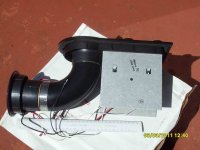 Athena 1.jpg223.8 KB · Views: 51
Athena 1.jpg223.8 KB · Views: 51 -
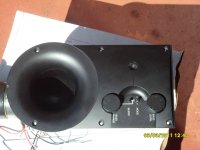 Athena 2.jpg186.2 KB · Views: 47
Athena 2.jpg186.2 KB · Views: 47 -
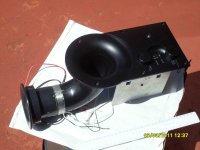 Athena 3.jpg191.4 KB · Views: 52
Athena 3.jpg191.4 KB · Views: 52 -
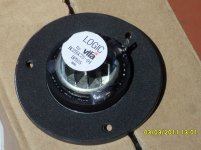 Vifa-1.jpg186.2 KB · Views: 20
Vifa-1.jpg186.2 KB · Views: 20 -
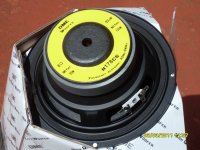 DME 2.jpg261.3 KB · Views: 22
DME 2.jpg261.3 KB · Views: 22 -
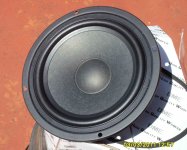 DME 1.jpg206.7 KB · Views: 42
DME 1.jpg206.7 KB · Views: 42 -
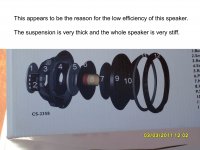 Venom 1.jpg216.8 KB · Views: 20
Venom 1.jpg216.8 KB · Views: 20 -
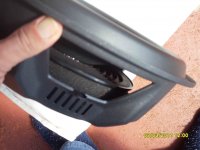 Venom 2.jpg238.2 KB · Views: 21
Venom 2.jpg238.2 KB · Views: 21 -
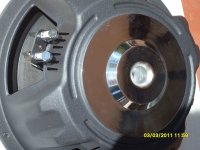 Venom 3.jpg327.3 KB · Views: 18
Venom 3.jpg327.3 KB · Views: 18 -
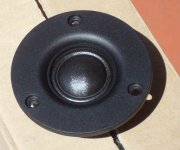 Vifa 2.jpg96.9 KB · Views: 18
Vifa 2.jpg96.9 KB · Views: 18
Good bass performance has as much to do with your room/speaker working as a team, including placement, room damping, attention to modes etc. The actual driver has some effect but probably not as much as you suspect.
This guy in post 2 seems enthusiastic. (no one I know )
)
Venom subs [Archive] - The Australian Magna Club
This guy in post 2 seems enthusiastic. (no one I know
Venom subs [Archive] - The Australian Magna Club
Further simulations lead me to believe that the 140L box is not far from the best compromise. If you go bigger you don't get significantly better performance. I updated the driver characteristics with the extra data you found on the box.
I have simulated a 140L box with the port you described 7cm by 29cm and this looks like it will work quite well. (Black trace)
The chap on ebay AU who is selling them recomended a port that works out to 7cm by 22cm but the difference is so small I don't think I would modify them. (orange trace)
Still probably the best musical sound would be a closed box and I have simualted two options a 140L box and 250L box (Red and Blue traces) as you can see the difference between them is so small there is no point in housing a larger box.
The purple trace is what the Win ISA program created as a sub-chebyshev alignment. This will sound awfull as it has far to much deep bass and with boundary and room gain is boud to sound boomby. Just goes to show you can't assume a program will give you a sensible result. It is a chebyshev alignment but in this situation that is not what you want.
So my recomendation is make a 140L box using your existing plate amplifer port and see what it sounds like. If you find you have too much deep bass and it is booming block the port. But try several locations first as subwoofers interact with the room very significantly.
Regards,
Andrew
I have simulated a 140L box with the port you described 7cm by 29cm and this looks like it will work quite well. (Black trace)
The chap on ebay AU who is selling them recomended a port that works out to 7cm by 22cm but the difference is so small I don't think I would modify them. (orange trace)
Still probably the best musical sound would be a closed box and I have simualted two options a 140L box and 250L box (Red and Blue traces) as you can see the difference between them is so small there is no point in housing a larger box.
The purple trace is what the Win ISA program created as a sub-chebyshev alignment. This will sound awfull as it has far to much deep bass and with boundary and room gain is boud to sound boomby. Just goes to show you can't assume a program will give you a sensible result. It is a chebyshev alignment but in this situation that is not what you want.
So my recomendation is make a 140L box using your existing plate amplifer port and see what it sounds like. If you find you have too much deep bass and it is booming block the port. But try several locations first as subwoofers interact with the room very significantly.
Regards,
Andrew
Attachments
Still probably the best musical sound would be a closed box and I have simualted two options a 140L box and 250L box
Do you get the impression this driver was designed for infinite baffle (car boot) loading? Shame about the sensitivity.
Estimated powerhandling of the simulated 140 Liter box would be quite low, and adding it to the 85 dBL sensitivity it looks to me it would be lacking sound pressure lvl quite badly.
I1d still say those drivers are not ment for this usage. Prehaps some higher order box might work out. But the main problem is that speakers like this are ment for a rolloff os fomething close to 60hz or so, thats usual for car usage.
I1d still say those drivers are not ment for this usage. Prehaps some higher order box might work out. But the main problem is that speakers like this are ment for a rolloff os fomething close to 60hz or so, thats usual for car usage.
- Status
- This old topic is closed. If you want to reopen this topic, contact a moderator using the "Report Post" button.
- Home
- Loudspeakers
- Multi-Way
- Will this Crossover work?
